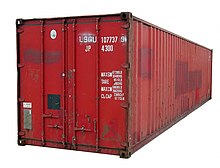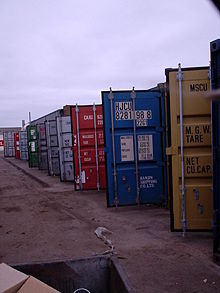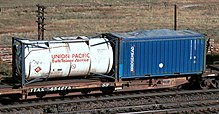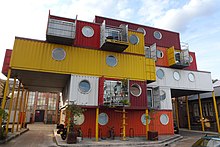| Revision as of 17:13, 19 August 2013 edit50.201.113.119 (talk) Rephrased small section due to grammar under 53 foot container section.Tag: Visual edit← Previous edit | Revision as of 19:50, 21 August 2013 edit undoRjensen (talk | contribs)Autopatrolled, Extended confirmed users, File movers, Pending changes reviewers, Rollbackers227,174 edits →Further reading: add citeNext edit → | ||
| Line 192: | Line 192: | ||
| ==Further reading== | ==Further reading== | ||
| * George, Rose. ''Ninety Percent of Everything: Inside Shipping, the Invisible Industry That Puts Clothes on Your Back, Gas in Your Car, and Food on Your Plate'' (2013), describes typical sea voyage | |||
| * ] (ISO), ''Freight containers'', Volume 34 of ISO standards handbook, International Organization for Standardization, 4th edition, 2006. ISBN 92-67-10426-8 | * ] (ISO), ''Freight containers'', Volume 34 of ISO standards handbook, International Organization for Standardization, 4th edition, 2006. ISBN 92-67-10426-8 | ||
| * Levinson, Marc |
* Levinson, Marc. ''The box : how the shipping container made the world smaller and the world economy bigger''], Princeton, N.J. : Princeton University Press, 2006. ISBN 0-691-12324-1 | ||
| * Donovan, Arthur & Bonney, Joseph "The Box That Changed The World", East Windsor, New Jersey, Commonwealth Business Media, 2006 ISBN 978-1-891131-95-0 | * Donovan, Arthur & Bonney, Joseph "The Box That Changed The World", East Windsor, New Jersey, Commonwealth Business Media, 2006 ISBN 978-1-891131-95-0 | ||
Revision as of 19:50, 21 August 2013









An intermodal container (also container, freight container, ISO container, shipping container, hi-cube container, box, conex box and sea can) is a standardized reusable steel box used for the safe, efficient and secure storage and movement of materials and products within a global containerized intermodal freight transport system. "Intermodal" indicates that the container can be moved from one mode of transport to another (from ship, to rail, to truck) without unloading and reloading the contents of the container. Lengths of containers, which each have a unique ISO 6346 reporting mark, vary from 8 to 56 feet (2.438 to 17.069 m) and heights from 8 feet (2.438 m) to 9 feet 6 inches (2.896 m). There are approximately seventeen million intermodal containers in the world of varying types to suit different cargoes. Aggregate container capacity is often expressed in twenty-foot equivalent units (TEU) which is a unit of capacity equal to one standard 20 ft × 8 ft (6.10 m × 2.44 m) (length × width) container.
For air freight the alternative and lighter IATA-defined unit load device is used. Non-container methods of transport include bulk cargo, break bulk cargo and tank cars, tank trucks or oil tankers used for liquids or gases.
History
Main article: ContainerizationThe standardised steel shipping container has its origins in the 1950s when commercial shipping operators and the United States military started developing such units. Shipping owner Malcom McLean worked with engineer Keith Tantlinger to develop the modern intermodal container. The logistics method employing these was named Container Express and was abbreviated ConEx. That abbreviation evolved into a word within the American English lexicon.
ISO standards for containers were published between 1968 and 1970 by the International Maritime Organization. These standards allow for more consistent loading, transporting, and unloading of goods in ports throughout the world, allowing for saved time and resources.
The International Convention for Safe Containers is a 1972 regulation by the Inter-governmental Maritime Consultative Organization on the safe handling and transport of containers. It decrees that every container travelling internationally is supplied with a "CSC-Plate".
Description
A typical container has doors fitted at one end, and is constructed of corrugated weathering steel. Containers were originally 8 feet (2.44 m) wide by 8 feet (2.44 m) high, and either a nominal 20 feet (6.1 m) or 40 feet (12.19 m) long. They could be stacked up to seven units high. At each of the eight corners are castings with openings for twistlock fasteners.
Taller units have been introduced, including "hi-cube" or "high-cube" units at 9 feet 6 inches (2.896 m) and 10 feet 6 inches (3.2 m) high. The United States and Canada often use longer units at 48 ft (14.63 m) and 53 ft (16.15 m).
The "pallet wide" containers are about 2 inches (5 cm) wider than standard containers to accommodate Euro-pallets, common in Europe. These containers feature an internal width of 2,440 mm (96.1 in) for easy loading of two 1,200 mm (47.2 in) long pallets side by side – many sea shipping providers in Europe allow these as overhangs on standard containers are sufficient and they fit in the usual interlock spaces (with the same floor panel the side ribs of pallet-wide containers are embossed to the outside instead of being molded to the inside). Australian RACE containers are also slightly wider to accommodate Australia Standard Pallets. Especially the 45 ft (13.72 m) pallet-wide high-cube shortsea container has gained wider acceptance as these containers can replace the 13.6 m (44.6 ft) swap bodies that are common for truck transport in Europe – the EU has started a standardization for pallet wide containerization in the EILU (European Intermodal Loading Unit) initiative.
Swap body units use many of the same mounting fixings as Intermodal containers, but have folding legs under their frame so that they can be moved between trucks without using a crane. They are generally lighter in weight. The containers flex during transport.
Container capacity is often expressed in twenty-foot equivalent units (TEU, or sometimes teu). An equivalent unit is a measure of containerized cargo capacity equal to one standard 20 ft × 8 ft (6.10 m × 2.44 m) (length × width) container. As this is an approximate measure, the height of the box is not considered; for example, the 9 ft 6 in (2.9 m) high cube and the 4-foot-3-inch (1.3 m) half height 20-foot (6.1 m) containers are also called one TEU. Similarly, the 45 ft (13.72 m) containers are also commonly designated as two TEU, although they are 45 feet (13.72 m) and not 40 feet (12.19 m) long. Two TEU are equivalent to one forty-foot equivalent unit (FEU).
Types
Variations on the standard container exist for use with different cargoes including refrigerated container units for perishable goods, tanks in a frame for bulk liquids, open top units for top loading and collapsible versions. Containerised coal carriers, and 'bin-liners' (containers designed for the efficient road/rail transportation of rubbish from cities to recycling and dump sites) are used in Europe.
Container types:
- Collapsible ISO
- Flushfolding flat-rack containers for heavy and bulky semi-finished goods, out of gauge cargo
- Gas bottle
- Generator
- General purpose dry van for boxes, cartons, cases, sacks, bales, pallets, drums in standard, high or half height
- High cube palletwide containers for europallet compatibility
- Insulated shipping container
- Refrigerated containers for perishable goods
- Open top bulktainers for bulk minerals, heavy machinery
- Open side for loading oversize pallet
- Platform or bolster for barrels and drums, crates, cable drums, out of gauge cargo, machinery, and processed timber
- Rolling floor for difficult to handle cargo
- Swapbody
- Tank container for bulk liquids and dangerous goods
- Ventilated containers for organic products requiring ventilation
- Garmentainers for shipping garments on hangers (GOH)
Specifications
Weights and dimensions of some common types of containers. Values vary slightly from manufacturer to manufacturer.
| 20′ container | 40′ container | 40′ high-cube container | 45′ high-cube container | ||||||
|---|---|---|---|---|---|---|---|---|---|
| imperial | metric | imperial | metric | imperial | metric | imperial | metric | ||
| external dimensions |
length | 19′ 10 1⁄2″ | 6.058 m | 40′ 0″ | 12.192 m | 40′ 0″ | 12.192 m | 45′ 0″ | 13.716 m |
| width | 8′ 0″ | 2.438 m | 8′ 0″ | 2.438 m | 8′ 0″ | 2.438 m | 8′ 0″ | 2.438 m | |
| height | 8′ 6″ | 2.591 m | 8′ 6″ | 2.591 m | 9′ 6″ | 2.896 m | 9′ 6″ | 2.896 m | |
| interior dimensions |
length | 18′ 8 13⁄16″ | 5.710 m | 39′ 5 45⁄64″ | 12.032 m | 39′ 4″ | 12.000 m | 44′ 4″ | 13.556 m |
| width | 7′ 8 19⁄32″ | 2.352 m | 7′ 8 19⁄32″ | 2.352 m | 7′ 7″ | 2.311 m | 7′ 8 19⁄32″ | 2.352 m | |
| height | 7′ 9 57⁄64″ | 2.385 m | 7′ 9 57⁄64″ | 2.385 m | 8′ 9″ | 2.650 m | 8′ 9 15⁄16″ | 2.698 m | |
| door aperture | width | 7′ 8 ⅛″ | 2.343 m | 7′ 8 ⅛″ | 2.343 m | 7′ 6" | 2.280 m | 7′ 8 ⅛″ | 2.343 m |
| height | 7′ 5 ¾″ | 2.280 m | 7′ 5 ¾″ | 2.280 m | 8′ 5″ | 2.560 m | 8′ 5 49⁄64″ | 2.585 m | |
| internal volume | 1,169 ft³ | 33.1 m³ | 2,385 ft³ | 67.5 m³ | 2,660 ft³ | 75.3 m³ | 3,040 ft³ | 86.1 m³ | |
| maximum gross weight |
66,139 lb | 30,400 kg | 66,139 lb | 30,400 kg | 68,008 lb | 30,848 kg | 66,139 lb | 30,400 kg | |
| empty weight | 4,850 lb | 2,200 kg | 8,380 lb | 3,800 kg | 8,598 lb | 3,900 kg | 10,580 lb | 4,800 kg | |
| net load | 61,289 lb | 28,200 kg | 57,759 lb | 26,600 kg | 58,598 lb | 26,580 kg | 55,559 lb | 25,600 kg | |
Security
Intermodal containers can be the target of break-ins and burglary when left unattended since they often contain valuable equipment and inventory. In these cases, a security system consisting of a motion detector and panel can trigger a siren, strobe, or light to deter intruders. Many panels offer wireless communication so that security guards can be alerted if an alarm is triggered.
Traditional motion detectors can be problematic because they are obstructed by the constantly moving equipment inside the container. Many break-ins occur by criminals cutting through a wall of the container, so the obstructed sensor becomes useless. Tomographic motion detectors work well in intermodal containers because they do not require a line of sight to detect motion. The entire container is covered by a sensing mesh that is not blocked by equipment or inventory. Tomographic motion detection is not prone to misdetection due to dirt buildup as is the case for beams and infrared sensors.
Larger containers
45 foot containers
53 foot container
Introduced in 1989, the 53 ft (16.15 m) shipping container is considered a High Cube container in that it is 9 ft 6 in (2.90 m) tall on the exterior. It is 1 ft (30 cm) taller than standard height containers. It is 8 ft 6 in (2.59 m) wide which makes it 6 in (15 cm) wider than standard containers. The bigger boxes have 60% more capacity than standard 40-foot (12.19 m) containers enabling shippers to consolidate more cargo into fewer containers. The original domestic 53-foot box OTR containers were introduced in 1989, but in November 2007 the first 53 foot ocean containers were introduced. All new, reinforced 53-foot boxes are built specifically for international trade and designed to withstand ocean voyages. According to APL, 53-foot containers could become the transport method of choice for customers moving cargo. In March 2013 APL stated that " no longer offers vessel space for 53-foot ocean containers in its trans-Pacific services. It has struggled to find sufficient amount of U.S. export cargo for them, while revenue on the eastbound leg has not been sufficient to cover the costs of repositioning empties back to Asia."
Reporting mark

Each container is allocated a standardized ISO 6346 reporting mark (ownership code), four characters long ending in either U, J or Z, followed by six numbers and a check digit. The ownership code for intermodal containers is issued by the Bureau International des Containers et du Transport Intermodal (41 rue Réaumur, 75003 - Paris France), hence the name BIC-Code for the intermodal container reporting mark. So far there exist only four-letter BIC-Codes ending in "U".
The placement and registration of BIC Codes is standardized by the commissions TC104 und TC122 in the JTC1 of the ISO which are dominated by shipping companies. Shipping containers are labelled with a series of identification codes that includes the manufacturer code, the ownership code, usage classification code, UN placard for hazardous goods and reference codes for additional transport control and security.
Following the extended usage of pallet-wide containers in Europe the EU had started the Intermodal Loading Unit (ILU) initiative. This showed advantages for intermodal transport of containers and swap bodies. This led to the introduction of ILU-Codes defined by the standard EN 13044 which has the same format as the earlier BIC-Codes. The International Container Office BIC agreed to only issue ownership codes ending with U, J or Z. The new allocation office of the UIRR (International Union of Combined Road-Rail Transport Companies) agreed to only issue ownership reporting marks for swap bodies ending with A, B, C, D or K – companies having a BIC-Code ending with U can allocate an ILU-Code ending with K having the same preceding digits. Since July 2011 the new ILU codes can be registered, beginning with July 2014 all intermodal ISO containers and intermodal swap bodies must have an ownership code and by July 2019 all of them must bear a standard-conforming placard.
Handling and transport

Containers can be transported by container ship, semi-trailer truck, Sidelifter and freight trains as part of a single journey without unpacking and they are transferred between modes by container cranes at container terminals. Units can be secured during handling and in transit using "twistlock" points located at each corner of the container. Every container has a unique BIC code painted on the outside for identification and tracking, and is capable of carrying up to 20–25 tonnes (19.7–24.6 long tons; 22.0–27.6 short tons). Costs for transport are calculated in twenty-foot equivalent units (TEU).
Rail
When carried by rail, containers may be carried on flatcars or well cars. The latter are specially designed for container transport, and can accommodate double-stacked containers. However the loading gauge of a rail system may restrict the modes and types of container shipment. The smaller loading gauges often found in European railroads will only accommodate single-stacked containers. In some countries, such as the United Kingdom, there are sections of the rail network through which high-cube containers cannot pass, or can pass through only on well cars. On the other hand, Indian Railways runs double-stacked containers on flatcars under 25 kV overhead electrical wires. In order to do this, the wire must be at least 7.45 metres (24 ft 5 in) above the track, but IR is able to do so because of its large loading gauge and the extra stability provided by its 1676 broad gauge track. China Railways also runs double-stacked containers under overhead wires, but must use well cars to do so, since the wires are only 6.6 metres (21 ft 8 in) above the track and 1,435 mm (4 ft 8+1⁄2 in) (standard gauge) does not provide adequate stability to run double-stacked containers on flat cars.
Securing loads in intermodal containers
Main article: Load securingThere are many established methods and materials available to stabilize and secure cargo in intermodal containers. Conventional restraint methods and materials such as steel strapping and wood blocking & bracing have been around for decades and are still widely used. Polyester strapping and lashing, synthetic webbings are also common today. Dunnage Bags, also known as "air bags" are used to help keep unit loads in place.
Flexi-bags can also be directly loaded, stacked in food-grade containers. Indeed their standard shape fills the entire ground surface of a 20'ISO container.
Non-shipping uses


Containers have been used for other purposes at the end of their voyaging lives. Permanent or semi-permanent placement for storage is common. A container has 8,000 lb (3,629 kg) of steel which takes 8,000 kWh (28,800 MJ) of energy to melt down. Repurposing used shipping containers is increasingly a real solution to both social and ecological problems.
Shipping container architecture employs used shipping containers as the main framing of modular home designs, where the steel may be an integrated part of the design, or be camouflaged into a traditional looking home. They have also been used to make temporary shops, cafes, and computer datacenters, e.g. the Sun Modular Datacenter.
See also
- BBC Box
- Container ship
- Drum (container)
- Intermediate bulk container
- Logistics Vehicle System
- MIL STD 129
References
- "Containers". World Shipping Council. Retrieved 2010-04-20.
'containers' of various standard sizes – 20-foot (6.1 m), 40-foot (12.19 m), 45-foot (13.72 m), 48-foot (14.63 m), and 53-foot (16.15 m) ... There are more than 17 million container units equating to more than 26 million TEU in the global container fleet
- Intermodal Marine Container Transportation: Impediments and Opportunities, Issue 236 // National Research Council: The container revolution (page 17-18): "This led to the development after the war of the 6- by 6- by 6-foot steel-clad Container Express (Conex) box used for military shipments on commercial vessels"
- Bartsch, Butsri. "Sea freight - somehow antique yet modern!". Retrieved 20 May 2013.
- "International Convention for Safe Containers (CSC) – Adoption: 2 December 1972; Entry into force: 6 September 1977". Imo.org. Retrieved 2013-02-01.
- International Convention for Safe Containers (Geneva, 2 December 1972)
- "Shipping Container Homes Globally". Retrieved 2009-05-24.
- "Container sizes". Shipsbusiness.com. Retrieved 2013-02-01.
- "Standard Shipping Containers". Container container. Retrieved 2009-05-18.
- http://www.matts-place.com/intermodal/part4/gesu4710896.jpg
- Frederik Hallbjörner, Claes Tyrén (2004). "Possible consequences of a new European container standard (EILU)" (PDF). master thesis.
- "GTRI Develops New Technologies to Secure Cargo Containers". PhysOrg.com. 2009-09-07. Retrieved 2011-05-08.
- "The 20 Foot Shipping Container". Shipping-container-housing.com. Retrieved 2013-02-01.
- "20 Foot Container Dimensions, 20' Ft Containers Sizes". Shippingcontainers24.com. Retrieved 2013-02-01.
- "Selecting a Container" (PDF). CMA CGM Group. 2006. Retrieved 2008-02-14.
- "Types and dimensions". Foreign-trade.com. Retrieved 2013-02-01.
- "DB Schenker Logistics offers new solution for garments on hangers | 3PL". 3plnews.com. 2010-07-07. Retrieved 2013-02-01.
- ^ "Containershippings.com". Containershippings.com. Retrieved 2013-02-01.
- "53ft High Cube Container | 53' High Cube Container | Container Technology, Inc". Containertech.com. Retrieved 2013-02-01.
- "Big Boxes bring Big Questions - Eric Joiner's Freightdawg.com - The Logistics and Supply Chain Blog!". Freightdawg.com. 2007-11-05. Retrieved 2013-02-01.
- http://www.joc.com/maritime-news/container-lines/apl/apl-abandons-53-foot-ocean-containers_20130315.html
- http://www.transcom.mil/dtr/part-vi/dtr_part_vi_603.pdf
- "New markings of intermodal loading units in Europe" (PDF). International Union of Combined Road-Rail Transport Companies. 2011-05-10.
- Raghvendra, Rao (August 26, 2008). "Rlys reaches higher, sets world record". IndianExpress.com. Retrieved 2009-11-04.
- International Standards
- ASTM D5728-00 Standard Practices for Securement of Cargo in Intermodal and Unimodal Surface Transport
- ISO 9897:1997 Freight containers – Container equipment data exchange (CEDEX) – General communication codes
- ISO 14829:2002 Freight containers – Straddle carriers for freight container handling – Calculation of stability
- ISO 17363:2007 Supply chain applications of RFID – Freight containers
- ISO/PAS 17712:2006 Freight containers – Mechanical seals
- ISO 18185-2:2007 Freight containers – Electronic seals
- ISO/TS 10891:2009 Freight containers – Radio frequency identification (RFID) – Licence plate tag
Further reading
- George, Rose. Ninety Percent of Everything: Inside Shipping, the Invisible Industry That Puts Clothes on Your Back, Gas in Your Car, and Food on Your Plate (2013), describes typical sea voyage excerpt and text search
- International Organization for Standardization (ISO), Freight containers, Volume 34 of ISO standards handbook, International Organization for Standardization, 4th edition, 2006. ISBN 92-67-10426-8
- Levinson, Marc. The box : how the shipping container made the world smaller and the world economy bigger], Princeton, N.J. : Princeton University Press, 2006. ISBN 0-691-12324-1 excerpt and text search
- Donovan, Arthur & Bonney, Joseph "The Box That Changed The World", East Windsor, New Jersey, Commonwealth Business Media, 2006 ISBN 978-1-891131-95-0
External links
| Intermodal containers | ||
|---|---|---|
| Overview |  | |
| Transport | ||
| Handling | ||
| Types | ||
| Other | ||
| Rail transport freight rolling stock | |
|---|---|
| Enclosed equipment | |
| Open equipment |
|
| Non-revenue equipment | |


